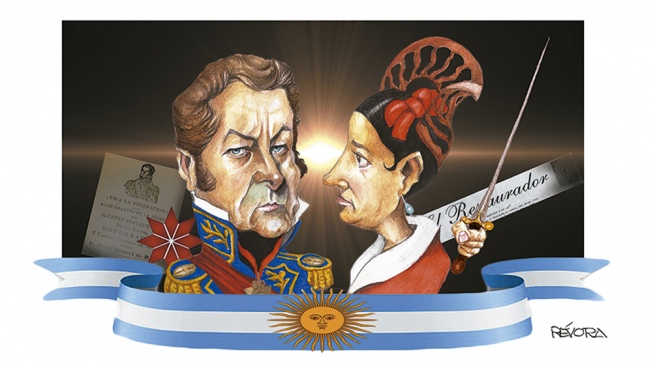The historian Vicente Fidel López described Juan Manuel de Rosas as a tall, Herculean male, with a blond face, blue eyes and a beautiful figure, who had an overwhelming ‘I don’t know what’. The Unitarians said that Encarnación Ezcurra was a brownish, ugly female with virile features, even nicknamed her “the Toribia mulatto”, in allusion to a knife maker of the time accused of killing several men.
But underneath the hate and historyalso of the victims and the perpetrators, A passionate and unconditional love flowed. A story that turned Juan Manuel and Encarnación into unavoidable protagonists of the Argentina in dispute, the one that began to be born as soon as the sounds of the May Revolution died down.
A story that, as well as being collective, is of two, of two “soul mates”, according to the romanticism that reigned at the time. Lucio V. Mancilla will say: “The incarnation of those two souls was complete. Perhaps Rosas loved no one as much as his wife, nor did anyone believe in him as much as she did.”. But in love, perhaps more than in politics, the good guys don’t always win, nor are passions enough to change everything.
It is that Juan Manuel, who was already 20 years old where this story jumps, and Encarnación, who in the salons did not give him more than the 18 he had, They fell in love once and for all. Even without considering that the boy who had shown courage and heroism in resisting the English invasions of 1806 and 1807, who commanded with relentless charisma in his own fields and othersthat boy, we said, should face the will of his mother.
But Juan Manuel and Encarnación had a plan, as a plan they had for almost everything that happened later in Buenos Aires, as a plan they had in life that they finally brought together to the very threshold of death.
A “forgotten” letter out there

Doña Agustina Josefa Teresa López de Osorio was a woman of strong character. Euphemism to designate authoritarian, rigid, implacable. In 1789 she married León Ortiz de Rosas, a Spanish officer who had been held captive by the Indians for too long. She ruled the family ranches keeping peons, gauchos and Indians at bay. He had ten children, the second of them Juan Manuel, with whom from the beginning he had a conflictive relationship.
When Juan Manuel told Mama Agustina that he had fallen in love with Encarnación (a member of Buenos Aires high society, to the scandal of the unitarians) and that they would marry immediately, she did not even look up from what she was doing. “Don’t even dream of it,” she sentenced.
“Or was it not Rivadavia who silenced the vote of the poor? Neither mulattoes nor countrymen nor illiterate. Oh, dear Juan Manuel, how I need you here, by my side”Encarnacion Ezcurra
The mother’s refusal was impossible to twist for someone who would become a a strong caudillo whose pulse did not tremble in a country that was still searching for a form of organization and a place in the world.
The charisma and commanding voice of Juan Manuel were not enough with his mother. Then, the brand new couple had a brilliant idea, which would scandalize the prudery of the time. The young Rosas “forgot” a letter from Encarnación on a table, in which she confessed that she was pregnant.
Since nothing was beyond Mama Agustina’s control, she took the letter and read it. She thus understood that knowing too much can have unintended consequences: vhe forgot his steps and consented to the marriage of his son.
Juan Manuel and Encarnación were married on March 16, 1813 and the “pregnancy” was one of the longest in history. Finally, they had three children: Juan Bustista (who would be born 14 months after the rigged letter); María de la Encarnación (who died the day after she was born); and Manuelita Robustiana (whose political activity together with her father will make her the political heiress of her mother).
What’s more, Juan Manuel and Encarnación adopted (and raised as their own until the age of thirteen) the newborn Pedro Pablo Rosas y Belgrano, son of Manuel Belgrano and his lover, María Josefa Ezcurra, sister of Encarnaciónwho accompanied him on the campaign with the Army of the North.
Neither the years nor the grandchildren loosened up on mother Agustina, who maintained a tense relationship with her second son. Juan Manuel left his parents’ house slamming the door loudly, abandoned the administration of the family’s ranches and changed his surname. It would no longer be Ortiz de Rozas. He would simply be called Rosas.
Side by side in the street

“Unitarians, always cross themselves in the face of force. They wrote it: we will impose unity with sticks. We, the disciples of Artigas, those of us who dreamed of the Great Homeland, were not the shooters of Dorrego; Rivadavia sowed the unitary foundation, the violence of disarming the army of our friend José de San Martín”.
“What other things than violence can oppose violence? Or Was it not Rivadavia who silenced the vote of the poor? Neither mulattoes nor countrymen nor illiterate. Oh, dear Juan Manuel, how I need you here, by my side”.
“The Unitarians, dear friend. The unitarians go after the husbands and what is whispered in the salons. They have the monarchy in their heads, between their legs, and in that way of addressing the town. Always commanding and never giving or promising anything.”
“They don’t like to be from the town and the town doesn’t like so much Frenchified lady. The town is something else: the town is Federal, the town is tripe, candombe, mozambique, molembós and, of course, bullets and stabs, and I am from the town. The Unitarians were born to hide on the border. And I was born to command among mine. And mine obey me and others fear me.
Thus Encarnación wrote; a woman of strong character, an impetuous woman who could become ruthless. This is how Encarnación wrote to Juan Manuel in 1833, when he participated in the Desert Campaign and she militated his return to the government in Buenos Aires. Thus she wrote a woman who was the protagonist of politics when it was the exclusive patrimony of men.
Passions do not mix, they are one. And that of Encarnación was Juan Manuel and that of Juan Manuel was Encarnación, and that of both was politics, it was Argentina torn apart by the confrontations between unitarists and federalists that followed independence from Spain.
We are much more than two

Rosas was proclaimed Governor of Buenos Aires by the Legislature on December 8, 1829. It was the end of a decade of fightingwhere with the last directory the national powers had been dissolved and the civil wars that pitted the port against the provinces seemed to diminish, although they would finally extend until the second half of the century.
Juan Manuel ruled until 1832 with Encarnación as hillside, companion and ally, while the dispute between the provinces delayed the national organization. His government contributed to the progress of Buenos Aires and the pacification of the border with the Indian.
That same year Rosas was re-elected by the Legislature, but decided to step aside to build new conditions that would allow him to face a fierce opposition determined to finish him off; Juan Ramón Balcarce, a federal non-Rosista, assumed the government.
Away from the government Rosas coordinated with the provinces of Mendoza, San Luis and Córdoba the so-called “Campaign of the Desert”, with the aim of advancing on the border of the territories dominated “by the Indian”. Rosas’s policy towards the original peoples alternated peace treaties, recognition and extermination.
But in Buenos Aires things happened. And in almost all of them was Encarnación. While Rosas’s prestige grew thanks to his leading role on the border, the internal confrontation between the federals led to the Revolution of the Restauradores. Thus, a popular uprising (encouraged by Encarnación) ended with the siege of the city, the resignation of Balcarce and the path paved by the return of Juan Manuel to power.
Encarnación’s leading role also included the formation of the Sociedad Popular Restauradora, a true political arm of Rosismo that had its military expression in La Mazorca.
Federation Hero
Rosas returned to government in April 1835 in a country shaken by the assassination of Facundo Quiroga and where political violence intensified. After being appointed by the Legislature, the Restorer received popular support through a plebiscite.
With full powers and imposing leadership, Juan Manuel would rule until 1852, when he was defeated at the Battle of Caseros. next to him, as a woman and as a political activistwas Encarnación, already proclaimed “Heroine of the Federation”.
But death does not understand love, opportunity or titles and took his life on October 20, 1838. Encarnación Ezcurra was only 43 years old, 25 of which she shared with Juan Manuel de Rosas.
The remains of Encarnación were accompanied by some 25,000 people, half of the population of Buenos Aires at that time.
When Juan Manuel learned of his wife’s death, he locked himself in with her body and, holding her in his arms, cried alone. The funerals became an unprecedented political and popular act.
The funeral procession joined the Fort of Buenos Aires (headquarters of the government and located in the same place that the Casa Rosada occupies today) with the Convent of San Francisco (today Belgrano and Defensa), to which Encarnación was devoted.
“She seemed asleep”
In 1925, the family of Ortiz de Rosas decided to transfer the body of Encarnación Ezcurra from the Máximo Terrero mausoleum to the vault they owned in the Recoleta cemetery. But things did not happen as expected. After 87 years the body was intact.
“When the coffin was opened, we saw that Doña Encarnación’s body was intact, incorrupt, as if she had just died. Her hair, the skin of her face and hands, preserved her integrity, the same as the rest of her body, ”Bishop Marcos Ezcurra, present at the ceremony, recounted years later. “If she seemed asleep”, assumed the religious.
“Even dried flowers could be easily recognized. Many relatives took some as a souvenir… The urn could not be used for their remains. The body was buried a second time, as it was… There, through the glass, you can see the face still intact,” he recalled.
The body was accompanied by about 25,000 people, half of the population of Buenos Aires at that time. Juan Manuel ordered two years of mourning. He still had a long way to go. But now he had to go through it alone.
Rosas would die on March 14, 1877, almost 40 years after Encarnación, in English exile and with his daughter Manuelita at his side. A woman, another woman, who accompanied him in his bid to change history.














